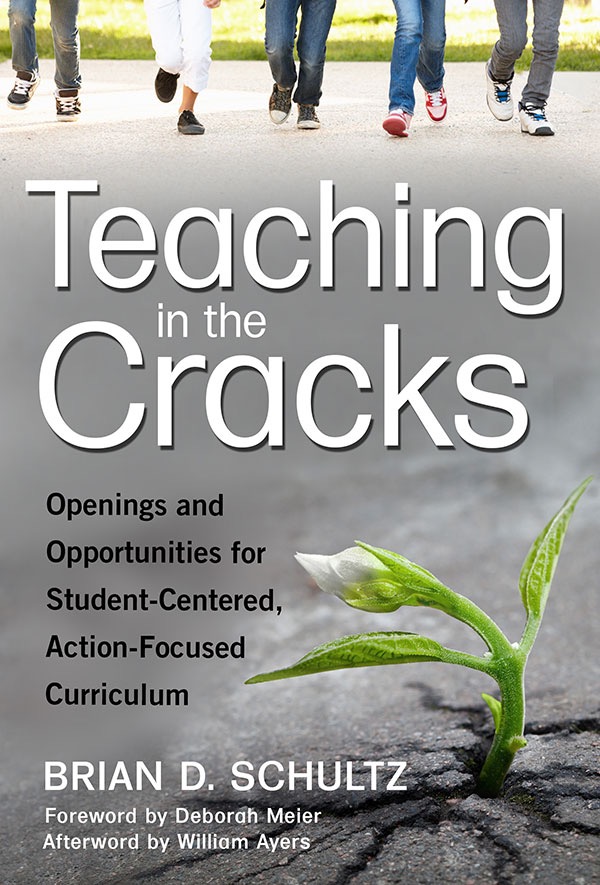student empowerment
Select an item by clicking its checkbox

Teaching in the Cracks
Date Reviewed: September 6, 2018
Brian D. Schultz New York, NY: Teachers College Press, 2017 (xiv + 128 pages, ISBN 9780807758311, $29.95) Teaching in the Cracks by Brian D. Schultz, a professor of education at Northeastern Illinois University in Chicago, explores ways to make current K-12 classrooms more student-empowering, justice-oriented, and action-based. It is not that already available curricula are not student-empowering, have no concern for justice, or ...
Teaching in the Cracks: Openings and Opportunities for Student-Centered, Action-Focused Curriculum
Brian D. Schultz
New York, NY: Teachers College Press, 2017 (xiv + 128 pages, ISBN 9780807758311, $29.95)
Teaching in the Cracks by Brian D. Schultz, a professor of education at Northeastern Illinois University in Chicago, explores ways to make current K-12 classrooms more student-empowering, justice-oriented, and action-based. It is not that already available curricula are not student-empowering, have no concern for justice, or seldom inspire creative student actions; What most concerns the author are school systems that dictate almost everything that students experience, think, and do. In such a system, says Schultz, learning is largely top-down, authoritarian, controlled by agendas that perpetuate the status quo, and “bombarded by standards, assessments, [and] evaluations” (86). Shultz’s critiques and enthusiasm focus on reforming this “troubling” system and more specifically on transforming current everyday curricula in classrooms (86). His proposal, however, stays at the level of reforming or transforming, rather than completely negating or overhauling our current educational practices. That is why he calls his suggestive methodology and transformative tactics “teaching in the cracks.” He encourages educators to find creative loopholes in the present system where they can make education more democratic, collaborative, and thus bottom-up.
Schultz acknowledges that his proposal sounds great on paper but is hard to implement in the classroom, and so throughout he offers numerous practical examples of proposed curricula and how they are working around the nation. Examples vary, covering everything from a single classroom, the entire school’s curriculum, forming close partnerships with surrounding communities, and specific topics, to teacher preparation (all covered in chapters two to six). Together they make this book an invaluable reference for field educators. In particular, chapter six, “Becoming the Teacher I Want to Be: Finding Support to Teach in the Cracks,” and chapter seven: “Turning the Corner: Techniques, Resources, and Tools for Taking-Action,” should be helpful for those who would like to implement the proposed learner-centered class education in a seemingly impotent school context. In chapter six, Schultz gives two fine examples of veteran teachers who introduced several effective strategies that are applicable to other contexts as well. To be sure, contexts differ. Yet, as long as a similar school structure is involved (for example, executive administrators, a sizable student body and its own governing entity, supportive community groups, and an aspiring teacher), these strategies would be beneficial anywhere. Websites introduced in chapter seven are extremely useful resources too.
This book is not per se a theoretical book on student-centered, action-focused curriculum. Rather, it is full of vivid examples of actual current practices. Some readers may find this book insufficiently radical to make a dramatic change in the existing school system, but that is not the author’s purpose. Its particular strength lies in its unabashed focus on the classroom itself. The author believes that the real change can and must happen in each individual classroom where the teacher and students meet for daily education, before any large-scale systematic change is possible. In this respect, this book provides a small, yet reliable, hope for most field educators who, like me, aspire to create a more learner-led class environment.

Breakthrough Strategies: Classroom-Based Practices to Support New Majority College Students
Date Reviewed: November 30, -0001
This book is about preparing for a future already dawning on North American college campuses, a future belonging to “New Majority” (NM) students. Ross describes NM students as Latino/a, African-American, Southeast Asian, Pacific Islander, first generation, and low income. Evidence of NM students is statistically demonstrable, as with the 50% rise of Pell Grant applicants between 2002-13. Demographic surges suggest a “majority-minority” U.S. by 2050. These students often have an educational disadvantage, met in some places with "bridge programs" or other efforts to bolster their success. But is more needed? Are faculty aware and equipped enough to serve NM students, or will faculty continue to be befuddled when students do not speak up in class or react to assignments and grades in unexpected ways? This book addresses these issues by introducing professors to NM students so that they can better understand the cultural cues and expectations these students bring.
Part I, "Strategies for Engagement," assesses ways of keeping students engaged, but with special attention to issues NM students face. Chapters begin with classroom vignettes that set up the problem the chapter addresses. Students may disengage because of “stereotype threat,” a socio-psychological phenomenon described in chapter four. Professors best confront this stereotype by bolstering self-confidence while pushing students to engage subject matter more deeply. Students are reluctant to ask questions in class not because they are uninterested, but because they fear sounding ignorant or come with cultural traditions of deference that discourage public questioning. This mismatch of expectations between teacher and students can be confronted through strategies presented in chapter five.
Taken for granted as a privileged space with its own practices, the college classroom is strange new territory for NM students. Six chapters in parts II and III introduce strategies that build inclusion and confidence. For instance, NM students benefit from classroom cultures built around interdependence and teamwork rather than individual achievement, which can be perceived as selfish and disloyal in some minority communities. Journaling is another strategy that invites NM students to deeper reflection on a subject and builds connection with the instructor. It helps to overcome the assumption that learning is simply mastery of information delivered through lectures, as opposed to personal discovery and evaluation.
Journaling is an important ingredient in the wider purpose of creating leaders for minority communities who produce personal observations, share insights, and opinions with confidence, contributions which are valuable not only for minority communities but also for the wider society in which they will participate. NM students will graduate and enter a workforce where they will continue to face debilitating stereotypes (the final chapter’s opening vignette is about Gabriela, a Latina architecture student who faced negative stereotyping on her first day). College classrooms should be spaces of empowerment for these students so they can begin building a professional identity during their educational experience. Professors can facilitate this with frank discussions of stereotypes NM students will face, by sharing stories of role models, and by cultivating good practices in communication and self-presentation.
This book will sensitize faculty to the needs of this growing part of the student body. However, much of the information is applicable to students from all backgrounds, and will improve college teaching for all involved.
In my last blog, I reflected on my regret about the way that my classroom had become politicized in an election season in ways that I came to regret. Unexpectedly, I find myself once again politicizing my classroom; towards different ends this time. This time my act of radicalization is ...
God is unknowable. So, the things of God cannot be learned – they must be revealed. What does it mean to teach our students to wait for the revelation, to be aware of the revelation, to find joy in the revelation, to trust in the revelation? In what ways might students ...
Phil Salter, a current student and muse of this Blog, in describing himself as a seminarian, said, “I am learning on the fly.” Intrigued by this notion, I have been thinkalating … Habakkuk has come to mind….Recorded in Habakkuk (v. 2 & 3 Recorded in Habakkuk (v. 2 & 3), “Then the Lord answered ...

